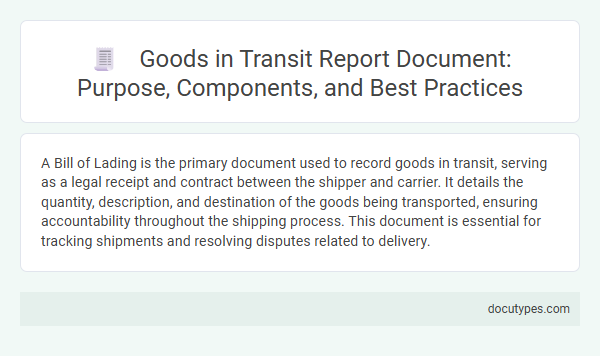A Bill of Lading is the primary document used to record goods in transit, serving as a legal receipt and contract between the shipper and carrier. It details the quantity, description, and destination of the goods being transported, ensuring accountability throughout the shipping process. This document is essential for tracking shipments and resolving disputes related to delivery.
Introduction to Goods in Transit Report Documents
Goods in transit must be accurately recorded to maintain clear ownership and accountability during shipment. Your logistics and accounting processes rely heavily on specific documents to track these goods effectively.
- Bill of Lading - A legal document issued by a carrier to acknowledge receipt of cargo for shipment.
- Shipping Manifest - A detailed list of the goods being transported, used to verify contents and quantities.
- Goods in Transit Report - An internal record summarizing the status and details of items currently being shipped between locations.
Purpose and Importance of Goods in Transit Reports
The document used to record goods in transit is commonly known as a Goods in Transit Report. This report tracks the movement and status of inventory while it is being transported between locations.
The purpose of a Goods in Transit Report is to provide accurate information about shipments that have left the sender but have not yet reached the receiver. This report ensures inventory records are up to date and helps prevent discrepancies in stock levels. Your supply chain management depends on this documentation to maintain accountability and optimize logistics operations.
Key Components of a Goods in Transit Report
A Goods in Transit Report is the primary document used to record shipments that are currently moving between locations. This report tracks items to ensure accurate inventory management and timely delivery updates.
Key components provide essential information for monitoring and accountability in transit.
- Shipment Details - Includes the description, quantity, and identification numbers of the goods being transported.
- Transit Dates - Records the shipping date, expected delivery date, and current status updates during transit.
- Carrier Information - Lists the name and contact details of the transportation company responsible for the shipment.
Essential Information to Include in Transit Reports
What document is used to record goods in transit?
The Bill of Lading is the primary document used to record goods in transit. It serves as a receipt, contract, and title for the shipment, ensuring accurate tracking and legal proof of ownership.
What essential information should be included in transit reports?
Transit reports must include shipment details such as the Bill of Lading number, description of goods, quantity, and condition at dispatch. They should also document carrier information, origin and destination points, and timestamps of departure and arrival for precise tracking.
Roles and Responsibilities in Transit Reporting
The Bill of Lading is the primary document used to record goods in transit, serving as a legal receipt and contract between the shipper and carrier. Transport managers are responsible for verifying shipment details and ensuring accurate documentation during transit reporting. Warehouse personnel must update inventory records in real-time to reflect the movement of goods and support accurate tracking throughout the supply chain.
Step-by-Step Process for Preparing a Goods in Transit Report
A Goods in Transit report is used to document inventory moving between locations. This report ensures accurate tracking of shipments during transportation.
- Identify Shipment Details - Record the shipment date, origin, destination, and carrier information.
- List Items in Transit - Include descriptions, quantities, and item codes for all goods being transported.
- Verify Supporting Documents - Attach copies of bills of lading, shipping manifests, and any relevant delivery receipts.
Your accurate and timely preparation of this report helps maintain inventory accountability.
Common Challenges in Transit Documentation
Goods in transit are typically recorded using a Bill of Lading, which serves as a key document detailing shipment information and ownership. This document ensures legal protection and facilitates the tracking of goods during transportation.
Common challenges in transit documentation include errors in data entry and delays in document processing, which can disrupt supply chain schedules. Incomplete or inaccurate Bills of Lading often lead to disputes, financial losses, and legal complications between stakeholders.
Best Practices for Accurate and Timely Reporting
The Bill of Lading is the primary document used to record goods in transit, serving as a legal receipt and contract between the shipper and carrier. Accurate and timely reporting relies on detailed entries including shipment date, description of goods, quantity, and destination. Ensuring proper documentation helps prevent discrepancies and supports efficient supply chain management.
Compliance and Legal Considerations in Transit Reporting
| Document Type | Description | Compliance and Legal Considerations |
|---|---|---|
| Bill of Lading (BOL) | Official document issued by a carrier to acknowledge receipt of cargo for shipment. | Serves as legal proof of ownership and contract of carriage. Ensures adherence to transportation laws, customs regulations, and facilitates dispute resolution in case of loss or damage during transit. |
| Waybill | Non-negotiable document detailing shipment information used primarily for in-transit tracking. | Supports compliance by documenting cargo status and movement. Must align with carrier obligations and regulatory reporting requirements to maintain legal accountability. |
| Shipping Manifest | List of all goods on a specific vessel or transport vehicle. | Essential for customs clearance and regulatory inspections. Accurate manifests prevent shipment detainment and ensure compliance with international trade laws. |
| Delivery Receipt | Document confirming receipt of goods by the consignee at destination. | Validates delivery and transfer of responsibility. Important for compliance with contractual terms and for legal evidence in claims regarding transit discrepancies. |
To maintain full legal compliance, your transit reporting must include detailed and accurate records of goods in transit. Using these documents ensures transparency and aligns with regulatory frameworks governing transportation and trade.
What Document Is Used to Record Goods in Transit? Infographic

